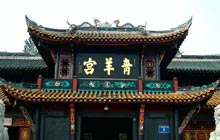 Qingyang Temple , which literally means Temple of the Dark Ram, is the most exquisite and active Daoist temple in Chengdu . The name is associated with many myths, such as Laozi (the mythical founder of Daoism) claiming that he would be reborn in a market where dark rams were sold, to a meeting of Daoist luminaries at which some dark rams were seen. Whatever the truth of the name, it was acquired in the ninth century after some remarkable phenomenon led to the unearthing of a box which contained a seal on which ancient characters with a Daoist message were carved. The temple has halls devoted to a number of luminaries in the Daoist firmament including Lao Zi, one of the trinity of the highest deities in Daoism; but also features halls with the Jade Emperor who ranks as the senior of the Heavenly Emperors, and other lesser deities. If you see religious or spiritual activities taking place that you might think belong elsewhere do not be too surprised. While Daoism does have its own gods and texts it has always been more open to other influences and will absorb ideas we might otherwise associate with Confucianism, Buddhism, or folk religion much more easily than other creeds will.
Qingyang Temple , which literally means Temple of the Dark Ram, is the most exquisite and active Daoist temple in Chengdu . The name is associated with many myths, such as Laozi (the mythical founder of Daoism) claiming that he would be reborn in a market where dark rams were sold, to a meeting of Daoist luminaries at which some dark rams were seen. Whatever the truth of the name, it was acquired in the ninth century after some remarkable phenomenon led to the unearthing of a box which contained a seal on which ancient characters with a Daoist message were carved. The temple has halls devoted to a number of luminaries in the Daoist firmament including Lao Zi, one of the trinity of the highest deities in Daoism; but also features halls with the Jade Emperor who ranks as the senior of the Heavenly Emperors, and other lesser deities. If you see religious or spiritual activities taking place that you might think belong elsewhere do not be too surprised. While Daoism does have its own gods and texts it has always been more open to other influences and will absorb ideas we might otherwise associate with Confucianism, Buddhism, or folk religion much more easily than other creeds will.
The Temple has a public sphere and a more private section where the monks live and practice. The grounds are well-manicured and extensive, and most of the present buildings in the complex date back to the seventeenth century. You can begin your visit with a rub of the ram statue for good luck and then go through to the main halls of worship. To get a good feel for how Daoist philosophy and indigenous Chinese folk religion are all mixed here together don't miss: the signs of the eight trigrams on the Bagua Ting (Pavilion of the Eight Trigrams); the 81 dragons referencing Chinese numerology; and the worshippers in the main hall shaking stalks out of a wooden cone. Once a stalk falls out, the worshipper takes it to a side room where a Daoist Priest exchanges it for an appropriate reading to the silent question the worshipper has asked. If you're feeling lucky then shake a stick yourself or try to throw some coins onto your Chinese zodiac sign.
In addition to the wide-ranging philosophical and folk references within this sanctuary of Chinese thought, there is an impressive array of traditional Daoist activities. Alchemy, once hotly researched here, is related in its exploration of physical and biological laws to the temple's long-standing traditional Chinese medicine practice. The benefits of meditation are combined with precise muscular control in the artful exercise of taiqi as taught by the temple's resident master. The temple's tea ceremony is refined and developed in the same room used by its Daoist orchestra. The combination of richly varied ideologies, images, practices and arts seen in a visit to the Qingyang Temple feels like a celebration of some of the most original and intriguing aspects of traditional Chinese culture.
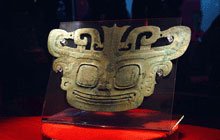 The museum at Sanxingdui, nearly 30 miles north of Chengdu, presents one of China 's most splendid, if mysterious, archeological finds. In 1929, when a collection of 400 multicolored jades were accidentally uncovered by a farmer here, this site was recognized as having rich potential; digs were organized in the 1930's by Gei Weihan, an American-Chinese professor, and then again in 1960's under Chinese direction. It wasn't until July 1986 however, that archaeologists discovered the two sacrificial pits containing hundreds of elaborate ivory, jade, gold and bronze artifacts that were to launch Sanxingdui onto the world stage. Intricate gold and bronze castings, dating from the first millennium BCE as well as ceramics from the third millennium BCE, revealed the remnants of a technologically-proficient ancient society and questioned the prevailing orthodoxy of Chinese culture originating in the Yellow River basin. Here was proof of a sophisticated culture from the Chengdu Plain that seemed to have little to do with its contemporary counterpart at Anyang in Hebei province (south of Beijing), but something to do with the cultures further down the Yangzi River.
The museum at Sanxingdui, nearly 30 miles north of Chengdu, presents one of China 's most splendid, if mysterious, archeological finds. In 1929, when a collection of 400 multicolored jades were accidentally uncovered by a farmer here, this site was recognized as having rich potential; digs were organized in the 1930's by Gei Weihan, an American-Chinese professor, and then again in 1960's under Chinese direction. It wasn't until July 1986 however, that archaeologists discovered the two sacrificial pits containing hundreds of elaborate ivory, jade, gold and bronze artifacts that were to launch Sanxingdui onto the world stage. Intricate gold and bronze castings, dating from the first millennium BCE as well as ceramics from the third millennium BCE, revealed the remnants of a technologically-proficient ancient society and questioned the prevailing orthodoxy of Chinese culture originating in the Yellow River basin. Here was proof of a sophisticated culture from the Chengdu Plain that seemed to have little to do with its contemporary counterpart at Anyang in Hebei province (south of Beijing), but something to do with the cultures further down the Yangzi River.
What does the slender, finely-worked gold scepter represent? What were the variously-sized, intriguing gold-plated bronze masks for? What do the magnificent bronze trees harboring strange birds, sun gods and other figures indicate? Not only can scholars not agree in their interpretations of these artifacts and symbols, they cannot even say which ancient culture of approximately three thousand years ago is represented by them.
Some say Sanxingdui is the forerunner to the later Shu culture (romanticized in the novel Three Kingdoms), others see strong central Asian influences. Whichever of those it may be, a vibrant artisanal connection with the bronze-working cultures of northern Thailand and southern Yunnan seems certain. Although many of the faces do not look especially Chinese, some of the bronzes carry Chinese patterns. What is remarkable is that Chinese records, usually so all-encompassing of anything that their brush could touch, are silent – we really just do not know. Another unknown is some of the technology used in the production of these cultural artifacts – without diamond-saws how on earth did they cut the jade so smooth?
What is beyond doubt is the quality of the magnificent bronzes – the strange huge mask with the protruding eyes, the enchanting shaman figure that may have once held an elephant tusk in his capacious hands, and the birds and other totemic animals of the 'divine trees', as well as other works.
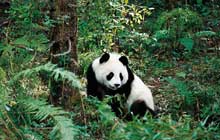 The cuddliest, cutest, best-behaved pet you could want for your bamboo garden? Whatever you end up thinking of this most peculiar creature, it is impossible to take your eyes off them, and the place to explore questions surrounding this dichromatic bear of bears is the Panda Research and Breeding Centre in Chengdu .
The cuddliest, cutest, best-behaved pet you could want for your bamboo garden? Whatever you end up thinking of this most peculiar creature, it is impossible to take your eyes off them, and the place to explore questions surrounding this dichromatic bear of bears is the Panda Research and Breeding Centre in Chengdu .
The panda is a native of the mountain forests in Sichuan , with some territory overlapping into the neighboring Gansu and Shaanxi Provinces . There are only a little over one thousand left in the wild, and over eighty percent of them are in Sichuan . Most of them are to be found in the mountain forests at the edge of the Tibetan Plateau. The government has taken a number of administrative steps to protect the pandas: they have introduced legislation against further logging in the habitat areas and have brought those areas under conservation orders. Despite this good work there are substantial worries about the long-term survival of the bears if left to their own devices; while there are around thirty distinct populations in the wild the majority of those populations have less than fifty individuals, not a high enough number to ensure survival. Partly to offset that lack of numbers this large institution on the outskirts of Chengdu was set up with the aim of increasing panda reproduction, and then training the young so that they can be released back into the wild. It is hoped that greater numbers and less fragmentation will eventually guarantee the species a future. However, the reproductive habits of the panda make this task much more difficult than it may appear. Female pandas only ovulate once a year, in the spring. This short period of two to three days is the only time she can conceive. She will give birth somewhere between three and seven months later. Births are usually single, and even when two cubs appear more often than not only one will survive. Because the panda young stay with their mother for a minimum of two years this generally means she can breed at most only every second year. With a life expectancy around thirty and a sexually active period of up to fifteen years it is easy to see why the population will take a long time to recover from any setbacks it suffers.
The institute covers a large area mostly of bamboo forests and a lake, and the animals here seem to like where they are. In the grounds you can often see both adults and young of the giant panda; the red panda and some water birds can also be found on the grounds. If you can take your eyes off the main attraction, the bamboo groves make for a pleasant stroll, especially if you've not experienced them before.
But the headline attraction cannot be anything but the giant pandas. They strip, shred, and eat bamboo with gusto; the young ones play in the trees and climb out on branches where they always elicit "oohs" and "aahs" from their rapt audience by balancing awkwardly from branches that seem to light to hold them. There aren't many places in the Chinese world where animals are so well on show.
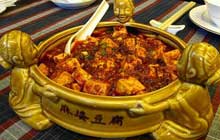 Day One
Day One
Today you will fly to Chengdu, the capital of modern Sichuan province. A historic capital serving as the traditional gateway to the Tibetan plateau, Chengdu has in recent years become a vibrant and sophisticated metropolis. Prepare yourself for mouth-watering Sichuan food, wonderful cultural sites and of course one of the rarest bears on our planet. (Shangri-la Hotel – Executive Riverview Room) (B, L, D)
Day Two
Early this morning we will take you to the Panda Research Institute, set within spacious parkland, where you will be able to observe pandas being fed a breakfast of bamboo shoots in their lush green pens.
Before lunch, we will visit a traditional Chengdu street to view, if not taste, some traditional Sichuanese street foods and tea-houses. This afternoon, you will drive an hour outside the city to visit one of the most mysterious archaeological discoveries of the twentieth century – Sanxingdui. The site is believed to date from the third millennium BCE. As well as cast bronze "sacred trees" on which stand molded singing birds and hundreds of jade and lacquer wares, there are a series of gold-plated bronze masks that are astonishingly beautiful. Compounding the archeological wealth of Sanxingdui is the silence of any historical record positioning this advanced civilization within the arc of China 's pre-history. This has wrapped the site in a shroud of mystery as intriguing and compelling as that of the Egyptian pyramids. (B, L, D)
Day Three
This morning, we will travel to one of China's most important Daoist Temples, Qingyang Temple. Daoism as a religious practice and institution incorporates a broad and set of historic disciplines within its belief system. As well as the worthwhile chemical and herbal research completed over the ages in pursuit of an "Immortality Pill", Qingyanggong also has a Daoist orchestra, a Taiji master, a Taiji tea instructor, a homeophathic doctor and a Daoist restaurant. Quite apart from a personal meeting with a Daoist monk to learn about such ideological matters as synchronicity, the Eight Trigrams and their interaction with the energy forces of Yin & Yang, visitors will be able to investigate some of the above disciplines and also tour the living quarters of the monks. You will be transferred to the airport in time for your flight to your next destination. (B, L)
Please note that B, L, D denotes Breakfast, Lunch Dinner.
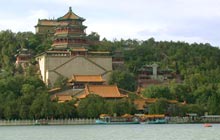 History
History
The history of the gardens at the New Summer Palace date back to the Mongol Emperor Kublai Khan; to improve Beijing's water supply, he ordered the construction of canals transporting water from the Western Hills to an enlarged lake, now known as the Summer Palace's Kunming Lake. Five hundred years later, Emperor Qianlong (r. 1736 – 1756) added lake-side gardens and a Temple for Gratitude and Longevity in honour of his mother's birthday.
It was not before 1875 however, that the New Summer Palace, in its current form, began to take shape. In an effort to curry favour with the Dowager Empress Cixi, her brother in law, after being appointed head of the navy, used money earmarked for new warships to build her a New Summer Palace. The Empress Dowager was thrilled by her present. The Chinese navy, on the other hand, was routed by a smaller Japanese fleet in the Sino-Japanese war of 1895.
Historical Significance
The Empress Dowager, who abhorred all challenges to her position, moved her administration to the New Summer Palace in 1889. Tales of her excesses are legion. The kitchens comprised eight courtyards, there were 128 eunuch cooks employed in her palace, five million silver taels were spent on her sixtieth birthday party, etc. And certainly when you consider that all 290 hectares of the summer palace were for the Dowager's exclusive use, you begin to see how the New Summer Palace came to symbolize the decadence of a venal dynasty.
The name, "The New Summer Palace", by definition draws the question – what happened to the old one? This was demolished in 1860 by Anglo-French forces. And as if once were not enough, the allied powers returned in 1900 to raze the newly reconstructed New Summer Palace. In this way the Summer Palaces – new and old – are also associated in popular culture with the destructive interference of foreigners on their land.
Neo-Daoist Ideal of Natural Harmony
The Summer Palace's enchanting lake-side scenery is not at all coincidental. It has been composed with as much care as a poem. The elliptical marble bridge leads the eye to the rocky South island in the middle of the lake, the wooden pavilions dotted sparingly on the gentle hills that adorn the lakeside, the grandiose temples that climb the artificially created Longevity Hill – all these represent a quintessentially Chinese ideal of harmony between man and nature. Enjoy the poem.
 Day One
Day One
Upon arrival at Beijing's Capital International Airport, you will be met at the gate by airport VIP staff who will lead you through immigration, baggage claim and customs. The remainder of the evening is at leisure. Treat yourself to a swim or spa treatment, take a stroll in the local neighborhood, or dine at one of our recommended restaurants (Raffles Hotel – Landmark Room).
Day Two
This morning we take you to one of ancient China's most sacred sites, the majestic Temple of Heaven. The afternoon's activities contrast colossal monuments of the past and present. After strolling across the impressive Tiananmen Square, an authoritative symbol of today's China, you will by awed by the majesty of the magnificent Forbidden City (as in Bertolucci's film "The Last Emperor"). Your tour here will include private access to the Emperor's private quarters, normally closed to the general public. (Please note that access to this site is controlled by local authorities, who may deny access on occasion. (B, L, D)
Day Three
Today you will visit the Great Wall which has fascinated generations of travelers. Whereas Genghis Khan contemplated it as a military obstacle, Richard Nixon saw it as one of humankind's greatest achievements. Spanning from the Gobi desert in the west to the Bohai Gulf in the east, it reaches as far back in time as the seventh century BCE and is being projected forwards as one of China's proudest symbols for the 2008 Olympics. While the utility and meaning of this defense mechanism has been contested by centuries of diplomats and invaders, its unprecedented scale will astonish you and its unexpected beauty will inspire you. You will be treated to a private banquet on the wall itself (weather permitting). (B, L, D)
Day Four 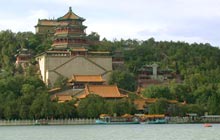
We begin with a pedicab tour through Beijing's historic alleyways (or hutong ). During this you will be afforded an insight into the everyday life of Beijingers. The hutongs ' intimacy contrasts with the poetic expanses you will see at our afternoon visit to the Summer Palace, a retreat built exclusively for the Dowager Empress Cixi. Its ornate temples, pavilions, and covered corridors, set amidst a graceful landscape, epitomize the refinement of this powerful matriarch. This evening's dinner perpetuates this sense of grace, leaving you with a wonderful memory of this Northern capital. (B, L, D)
Please note that B, L, D denotes Breakfast, Lunch Dinner.
The above itinerary is based on what past guests have generally enjoyed on a short visit to Beijing. No two guests are the same and while one might love to see the pandas at Beijing Zoo, another might prefer to hear a private lecture on Chinese literature in an elegant tea house. Please tell us your interests and we will customize an itinerary to suit. Guests who prefer to see more and rest less or who have more time to spend in Beijing, might choose to also visit the iconic Hutong neighborhoods, 798 Contemporary Art District, Lama and Confucius Temples, the West Qing Tombs or the East Qing Tombs. Note that these are only several of the additional sites in Beijing – you really could spend a couple of weeks here alone!
City tours are arranged on a private basis only. Visitors interested in a small-group tour of China, should view our frequent Imperial Tour itinerary.
 Renowned for its numerous gardens and canals, Suzhou is frequently mislabeled as the "Venice of the East". Its size and trading volumes though once significant nonetheless do not warrant such a grandiose comparison. Rather, it is best to think of Suzhou as the most distinguished of a multitude of canal towns, dotted around the Yangzi delta.
Renowned for its numerous gardens and canals, Suzhou is frequently mislabeled as the "Venice of the East". Its size and trading volumes though once significant nonetheless do not warrant such a grandiose comparison. Rather, it is best to think of Suzhou as the most distinguished of a multitude of canal towns, dotted around the Yangzi delta.
Suzhou's history dates back to the early seventh century BC at which time the semi-mythical ruler, He Lu, of the Kingdom of Wu is said to have founded the city. With the completion of the Grand Canal during the Sui dynasty (581-618 AD), Suzhou became a thriving commercial district as items such as silk were transported along the bustling waterways. Marco Polo recorded that its populace was comprised of "prudent merchants, and, as already observed, skilful in all the arts. They have also many persons learned in natural science, good physicians, and able philosophers."
During the Ming dynasty (1368 – 1644) with the increased concentration of silk manufacture here, Suzhou became an ever more fashionable cultural center. Thus by 1794, one of the members of Lord Macartney's ill-fated embassy to China described the town as having "(ruling) Chinese taste in matters of fashion and speech, and is the meeting place of the richest pleasure-seekers and gentlemen of leisure in China."
The city's good fortune ran out during the 1860's due to its occupation in the Taiping rebellion and then again in World War II by the Japanese. Today however, Suzhou is regaining its reputation for leisure as its visitors are afforded the rare opportunity to wander through the ancient gardens and homes of aristocrats, scholars and merchants. It is said that at one time, there were more than two hundred gardens in Suzhou. While not all of these still exist, some of the more famous such as those of the Humble Administrator and the Master of the Nets have been restored to their former beauty.
More recently, the city has been undergoing a new transformation. A Singaporean consortium, with the contribution of I.M. Pei, a Suzhou native, has helped to revive Suzhou's original architectural facade. Once more, Suzhou offers a parade of traditional white buildings and cobble-stoned walkways, lined with trees and flowering plants.
A further modern addition, indicative of the ingenious planning being invested in the city's renovation, is the newly built Sheraton Hotel. We will stop here for a dimsum lunch to admire the creative synthesis of traditional Chinese design with the demands of a modern luxury hotel.
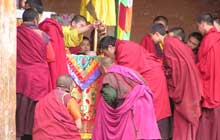 Shangri-La – is there another word so redolent of a utopia on the roof of the world? Since the publication of James Hilton's novel "Lost Horizon" in the 1930s, the western imagination has been gripped by the promise of an earthly paradise somewhere high in the Himalayas . Hilton had travelled in the region a few years before his novel was published, but never gave the exact location, and to this day it remains a mystery. (In a telling mirror image, Chinese culture has long been obsessed with a paradise somewhere to the West, near the Kunlun Mountains which run to the south of the Taklamakan Desert .) One of the present-day contenders for hosting this utopia was known in Chinese as Zhongdian County until 2002 when it officially changed its name to Shangri-La County . Its Tibetan name remains Gyalthang. Is this the real Shangri-La? You can form your own opinion, but it certainly has some of the necessary attributes. High up in the mountains at an altitude of over 10,000 feet, it is home to the Ganden Sumtseling Monastery in whose valley lie old Tibetan villages hinting at a pastoral utopia.
Shangri-La – is there another word so redolent of a utopia on the roof of the world? Since the publication of James Hilton's novel "Lost Horizon" in the 1930s, the western imagination has been gripped by the promise of an earthly paradise somewhere high in the Himalayas . Hilton had travelled in the region a few years before his novel was published, but never gave the exact location, and to this day it remains a mystery. (In a telling mirror image, Chinese culture has long been obsessed with a paradise somewhere to the West, near the Kunlun Mountains which run to the south of the Taklamakan Desert .) One of the present-day contenders for hosting this utopia was known in Chinese as Zhongdian County until 2002 when it officially changed its name to Shangri-La County . Its Tibetan name remains Gyalthang. Is this the real Shangri-La? You can form your own opinion, but it certainly has some of the necessary attributes. High up in the mountains at an altitude of over 10,000 feet, it is home to the Ganden Sumtseling Monastery in whose valley lie old Tibetan villages hinting at a pastoral utopia.
This modern-day Shangri-La did not begin life as a utopia, but was an important stop on the Tea and Horse Route that ran from Yunnan up into Tibet . South the path went down to Lijiang and the lower tea lands of Yunnan, while to the north the path skirted the magnificent Kawa Karpo Mountain, with its peak at over 20,000 feet, before heading into Tibet proper. Even today this route has been acknowledged as the best path from Yunnan into Tibet with the Chinese-made 'highway' running the path. Gyalthang, as the Tibetans call it, occupies a special position in Tibetan history. Its famous monastery (see below) was built at the behest of the Fifth Dalai Lama, and the town was where many of the eastern Tibetans or Kham would congregate and compete in horse skills and other contests. The town sits in one of the final valleys before the massive mountains stretch off to Tibet and western Sichuan . Through the tight valleys come three massive rivers, the Yangtse, the Mekong and the Salween , which between them flow to the sea as far apart as the coastlines of Burma and Shanghai . With those rivers also comes a variety of animal life, and the area is duly famed for the migrating birds that enrich the environment. Early summer also sees a profusion of alpine flowers decorating the valleys and mountains.
Having remained much on the margins of Chinese history, the turbulent 1930s saw the Communist armies come through the area on their Long March. The same armies returned some two decades later to make sure that the area was 'liberated' and that it would become wholly answerable to Beijing . Two theoretical utopias collided and for a time the Chinese Marxist version had the upper hand. The Cultural Revolution, from 1966-76, was mostly a dreadful experience for the ethnic minorities under Chinese rule. However, once the Maoist Socialist heaven ran its course, the possibility for individual business heavens became possible again, and the locals, in the town then known as Zhongdian, took well to this. In the late 1990s the local Tibetan farmers discovered that one of the many types of mushroom that flourished in their Eden, which they only rarely picked for themselves, was a fervently sought after fungus in Japan where the top quality local variety could fetch close to a thousand dollars per pound. For a few years it was estimated that more than half, and at times up to three-quarters, of the residents of this heaven were involved in one way or another in getting those mushrooms from the base of the pine trees to the plates of Japanese connoisseurs within a couple of days.
It is not only Westerners and Japanese who have been transfixed by the promises of this ideal world and what may be found there, the Chinese have long had a tradition that looked to this part of the world as the gateway to some form of eternal paradise. For the Chinese, these lands and mountains were the location of some of their earliest records of shamanistic spirit travel. It was home to the Western Paradise of Buddhism, and somewhere to the West lay the fabled Kunlun Mountains , where the Chinese immortals were reputed to live. To this very day, from spring on, when the snows begin to melt and the wild mountain herbs begin to grow the Tibetans can be seen on the streets of every major Chinese city, offering those herbs, with their promise of good health to those tempted by the dream of Shangri-La.
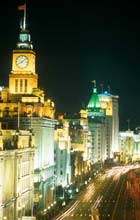
Few cities show as many contradictory aspects as westernized Shanghai. Those who glibly argue that this swinging city is all about money, not politics, should be reminded that the Chinese Communist Party was founded here. Others who see it as a city without a heart need only imagine the elation of those Jews who fled here from the Nazi Holocaust – at that time Shanghai was their only available refuge. Is Shanghai foreign or Chinese in essence, giving or grasping in nature, progressive or reactionary in politics? These are complex issues for you to ponder during your stay here.
Drugs, finance and war are, unfortunately, recurring themes in Shanghai’s turbulent history. This city’s foundation depended on this distasteful cocktail. Early in the nineteenth century, British and American trading firms sold opium to China as a means of offsetting their country’s huge and growing trade deficits. When China refused to play ball, the British sent a well armed expeditionary force to deal with the matter. In 1842, Her Majesty’s navy obliterated the quasi-medieval Chinese forces and demanded, amongst other things, the opening of five ports for international trade. One of those ports, Shanghai, was to become the most important on the Yangzi river, by 1898 servicing the equivalent of US$3.6 billion a year in British trade alone.
Extra-territoriality was a founding principle of the new city. It meant that in the American settlement, American law applied, in the British settlement, British law applied, and so on. Since these foreign territories provided much lower tax environments than China’s, it was not long before Chinese business people decamped from China proper to move their businesses and homes into the foreign concessions in Shanghai. As a result, local real estate prices sky-rocketed, and a triumvirate of financial, trade and real estate industries developed in the foreign enclaves.
However, this city, founded for opium traders, continued to depend on drugs distribution industries for its growth. By bribing foreign police forces, particularly the French one, secret gangs were also able to establish themselves in the concessions and from there control opium and heroine distribution operations. Such was the power and financial allure of these businesses that subsequent leaders of Shanghai, such as the Japanese army and the Kuomintang party, also pandered to them. After the civil war, when the Chinese Communist Party took control of Shanghai, the city’s commercial life was castrated. The drugs syndicates moved to Taiwan and Shanghai went into cold turkey.
These days, foreign business people are once more welcomed to Shanghai. Glamorous buildings are once more rising along the Huangpu river, and warm evening breezes once more carry the latest tunes. The difference is that these days it’s the Chinese who are throwing the parties.
Lying at China’s southern most point, Hainan Island has at various times been a Chinese penal colony, suffered invasion and exploitation by the Japanese, used as a port of free trade, and, in its current incarnation, is an island that China likes to compare with Hawaii. The comparison is not out of place as tourism and a naval base prop up the economies of both places.
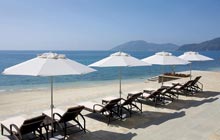 The first Chinese to settle Hainan Island were the Li people. During the Western Han Dynasty (206 BC to 24 AD), many of this Chinese ethnic minority moved from their original home in Guangxi Province to Hainan, displacing the island’s Aboriginal inhabitants.
The first Chinese to settle Hainan Island were the Li people. During the Western Han Dynasty (206 BC to 24 AD), many of this Chinese ethnic minority moved from their original home in Guangxi Province to Hainan, displacing the island’s Aboriginal inhabitants.
Originally referred to as ‘the gates of hell’, Hainan’s most famous exile was Su Dong Po, one of China’s best known literati. He was exiled to Hainan towards the end of the 11th Century for writing poetry criticizing the government. In 1098 the residents of the town that Su Dong Po resided established the Dongpo Academy in memory of him. (This was the second time he had been exiled. He was first exiled in Hangzhou where the famous pork dish Dong Po Rou was named after him. )
 During the 16th and 17th Centuries, the nation’s majority ethnic group, the Han Chinese, began to move to Hainan Island, pushing the Li people into the hilly, southern interior. Eventually the Li people rebelled, forcing the government to send in Miao minority mercenaries. Many of these Miao, originally from Guizhou Province, chose to settle in Hainan and now, these three ethnic groups make up 98% of Hainan’s population.
During the 16th and 17th Centuries, the nation’s majority ethnic group, the Han Chinese, began to move to Hainan Island, pushing the Li people into the hilly, southern interior. Eventually the Li people rebelled, forcing the government to send in Miao minority mercenaries. Many of these Miao, originally from Guizhou Province, chose to settle in Hainan and now, these three ethnic groups make up 98% of Hainan’s population.
Throughout its history, Hainan has been under the command of either Guangxi or Guangdong Provinces. The Second World War saw Japan invade and occupy Hainan for a brief period mining it for iron. At this time, the Chinese Communists and the Li Minority banded together to fight the Japanese, and, in 1950, wrested back control of the island.
In 1988, with Deng Xiao Ping opening the doors to China, the Chinese Government officially gave Hainan independent provincial status. It is from this time that the Hainan of today has developed – a tropical getaway, blessed with white sand beaches and clear blue skies, whose crescent bays are dotted with high-end international resorts. These resorts, together with secondary home real estate developments, have tilted the renown of this once purely agricultural economy away from rubber trees and fruit orchards to an international sun-seekers’ destination where affluent Chinese mix with foreigners in a place where practically everyone is on vacation.